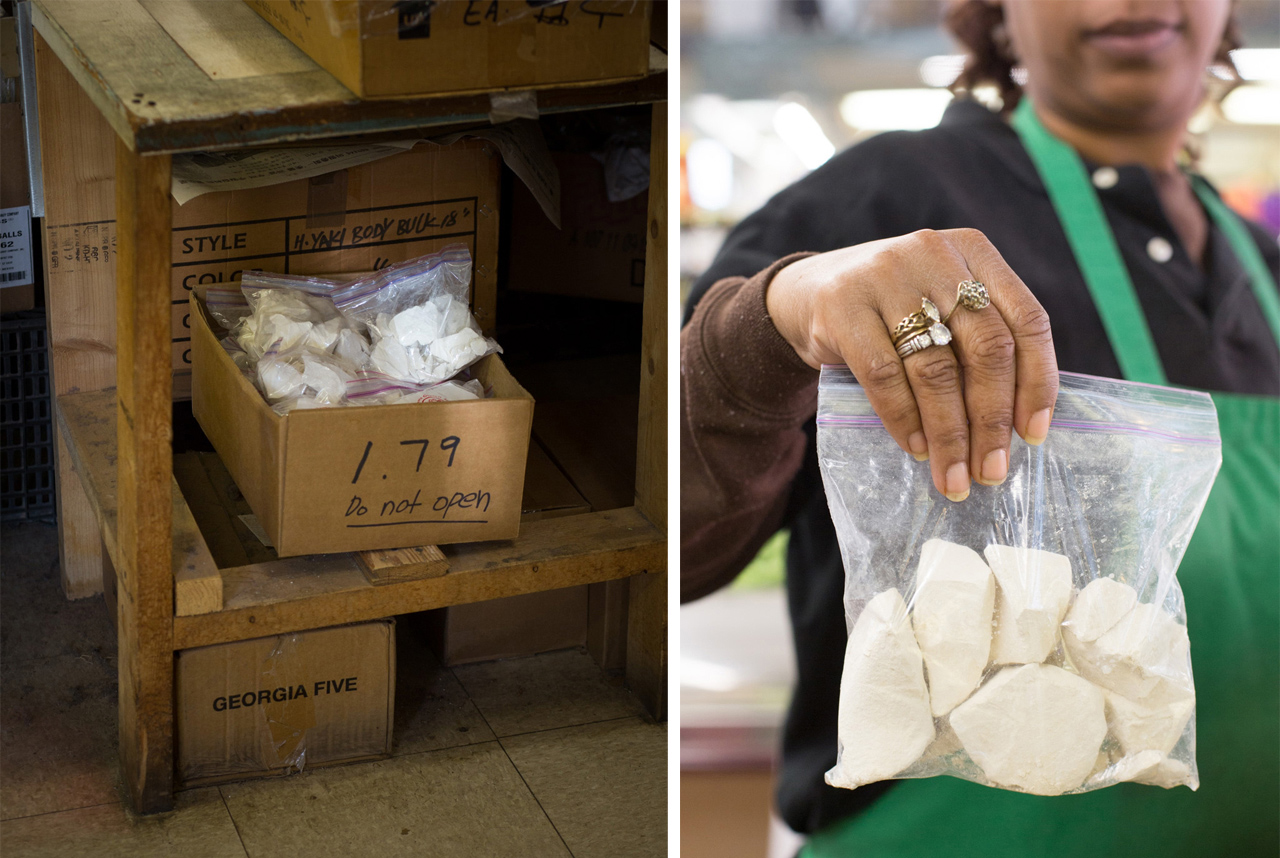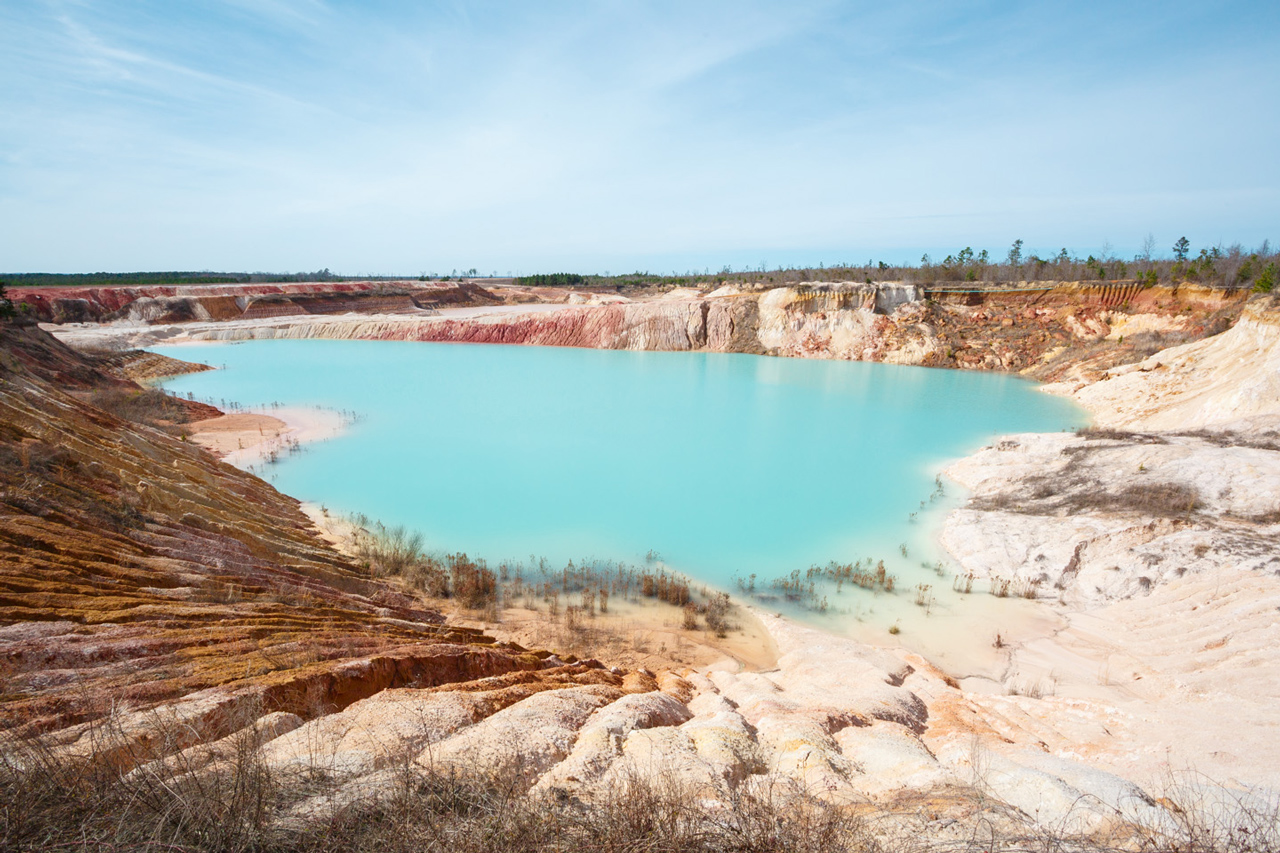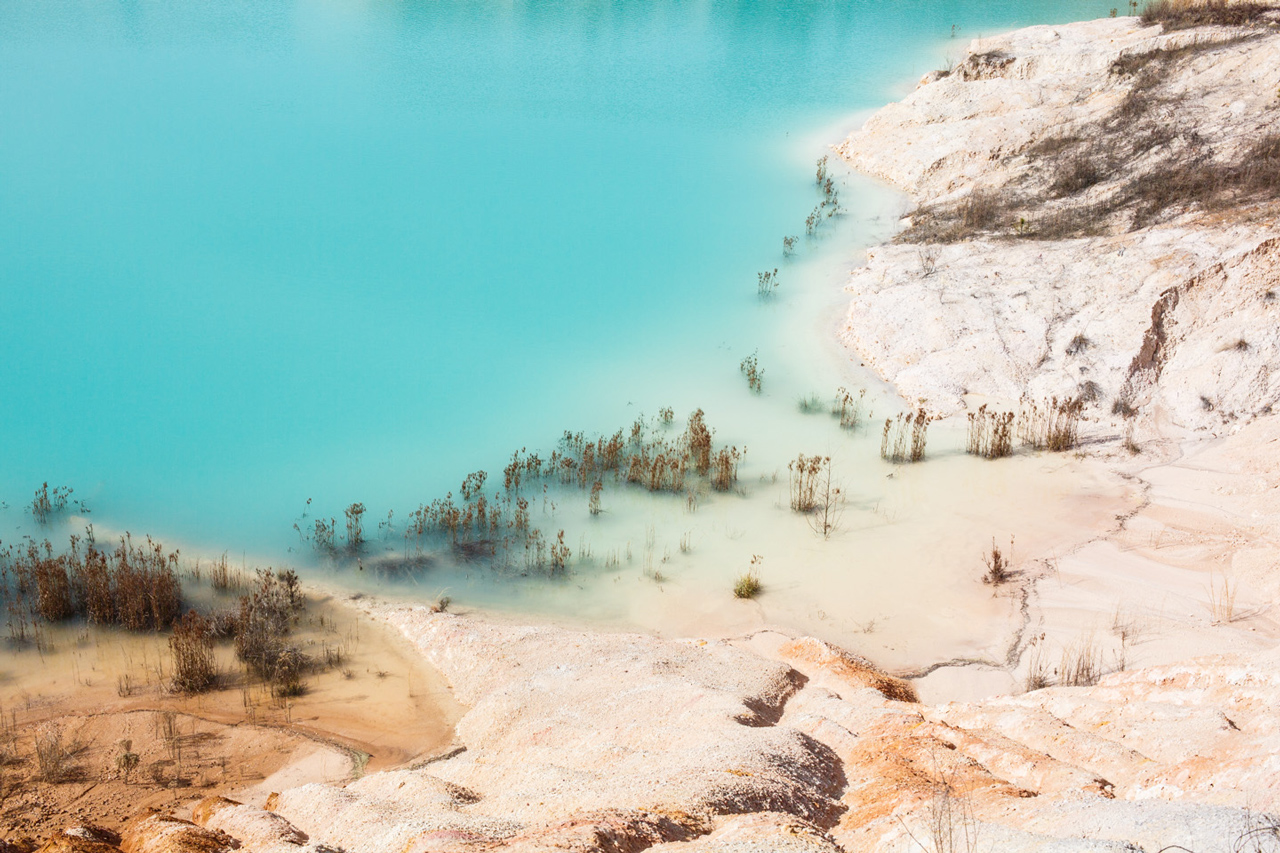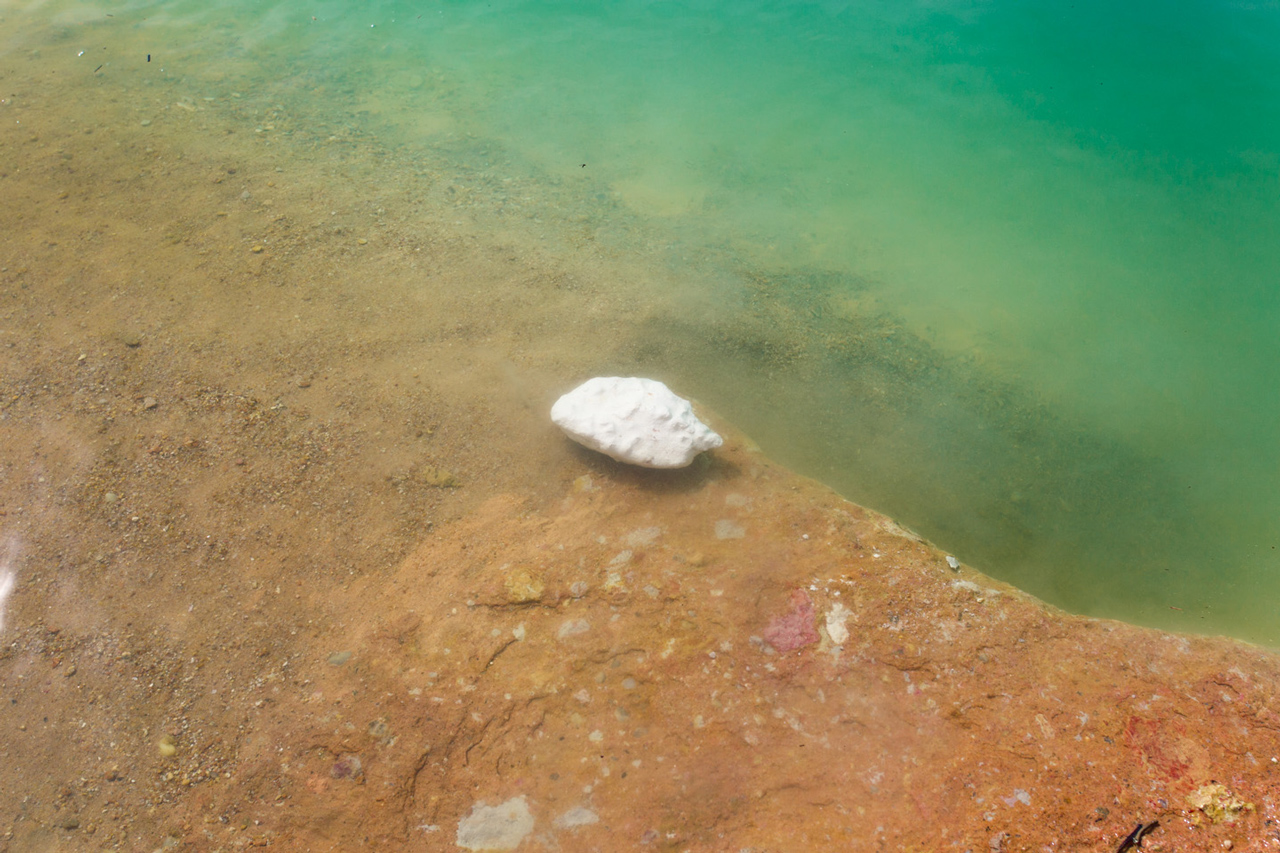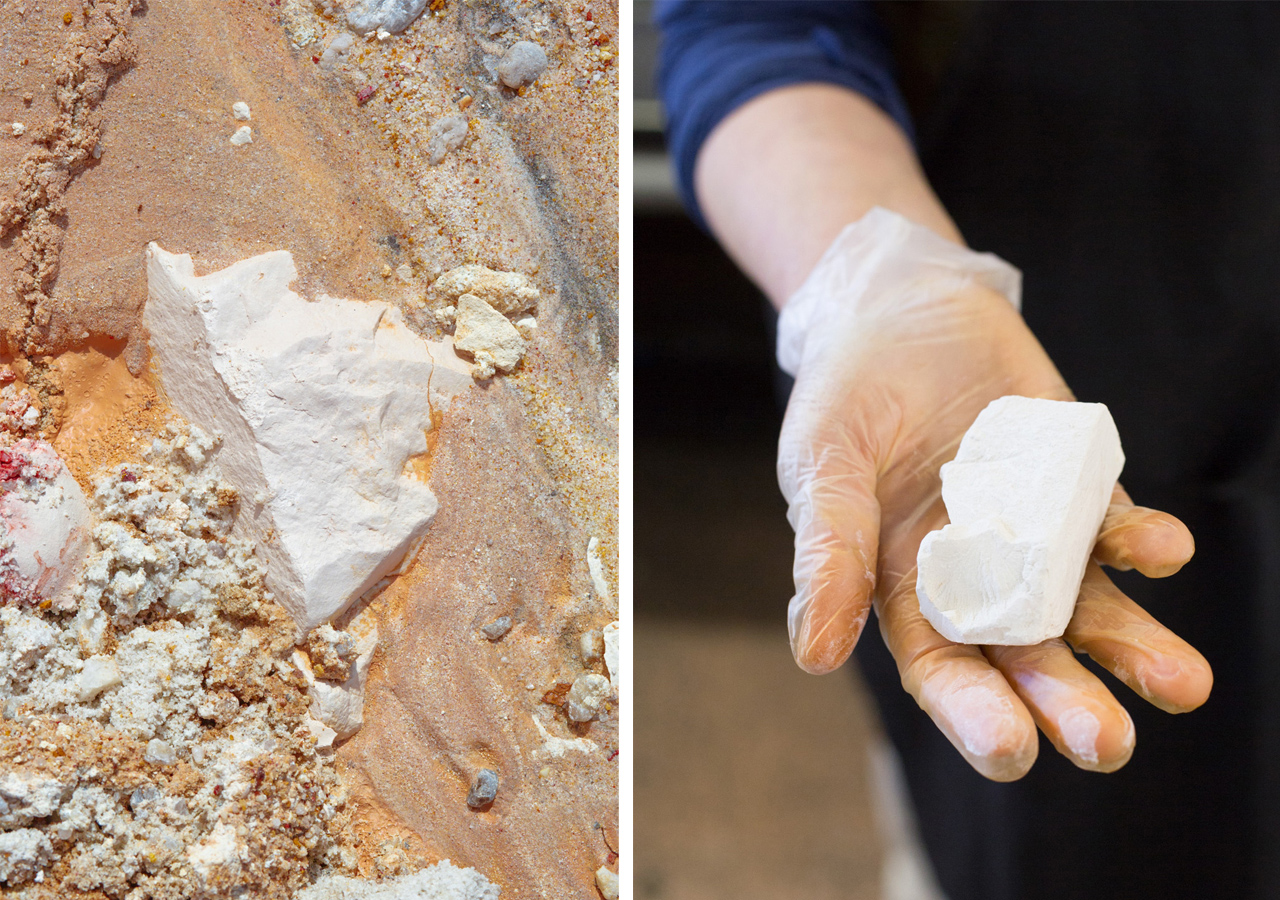Making Peace With the Age-Old Practice of Eating White Dirt
Story by Chuck Reece Video by Adam Forrester Photography by Troy Stains
The first time my Southern origin was used as a tool of mockery happened 30 years ago, on Valentine’s Day of 1984, when a man named Martin Beiser sent me a newspaper clipping.
I was less than a year out of college, working my first job as a reporter in the Atlanta bureau of Adweek magazine. Beiser worked for Adweek in New York at the time, and he later enjoyed a long reign as executive editor of GQ. The clipping he sent was from the Feb. 13 edition of The New York Times, a story in the national section under this headline:
“Southern Practice of Eating Dirt Shows Signs of Waning”
Beiser had clipped the piece from the Times on Monday and put it in the mail — with a brief, snarky, handwritten note — to his Southern colleagues in the Atlanta office.
My colleague Jeffry Scott and I, young and cocky reporters that we were, would not be outdone. Defense of our culture was in order, we thought. So we drove up Buford Highway to a service station that sold velvet Elvis paintings. We found a beauty — the King in profile, a tear running down his cheek — to which we added a small nameplate that read, “Elvis Wept,” our own snarky little riff on John 11:35. We packaged it up and mailed it to Marty, and after Adweek moved me to New York late that year, Marty and I overcame our cultural grudges and became friends. When I left Adweek in early 1988, I took “Elvis Wept” down from where Marty had hung it on the newsroom wall. Oddly enough, some of my New York co-workers protested. The power of the Southern thing had overcome them, I suppose.
“You can’t take Elvis!” one yelped. But I had bought “Elvis Wept” with my own money (and some of Jeffry’s), and by God, it was coming with me. It still hangs above my desk.
After Adweek, I took a job with another New York magazine, now long gone, called Channels of Communication. Channels sent me to Los Angeles to interview Linda Bloodworth-Thomason, the creator of “Designing Women” and arguably the first bitter Southerner who ever aired her grievances on a network sitcom, primarily through the voice of a character named Julia Sugarbaker.
During our interview, I asked Bloodworth-Thomason what motivated her to create a show that purposefully skewered stereotypes of the ignorant Southerner. She told me stories about the slights she’d encountered as a young Ozark woman who had arrived in Los Angeles in 1977 to teach school in the impoverished Watts neighborhood. I felt compelled to tell her my own little story about the arrival of “Southern Practice of Eating Dirt Shows Signs of Waning.”
On Dec. 5, 1988, I settled into a big chair in my apartment in Brooklyn to watch “Designing Women,” as we did most Thursday nights. In the episode, Julia Sugarbaker happens onto a story in The New York Times about people in the South eating dirt. She is incensed. She calls the writer at the Times but is not allowed to speak to him. After inquiring whether the secretary she’s speaking with can take shorthand, she delivers the following message:
“Just tell him that I’ve been a Southerner all my life, and I can vouch for the fact that we do eat a lot of things down here. We’ve certainly all had our share of grits, and I’m sure there are no self-respecting Southerners anywhere who haven’t consumed at least several tons of their mamas’ homemade biscuits and gravy. I myself have probably eaten enough fried chicken to feed a third world country, not to mention barbecue, cornbread, watermelon, fried pies, okra and yes, if I were being perfectly candid, I would have to admit we have also eaten our share of crow. And for all I know, during the darkest, leanest years of the Civil War, some of us may have had a Yankee or two for breakfast. But speaking for myself and hundreds of thousands of my Southern ancestors who have evolved through the many decades of poverty, strife and turmoil, I would like for Mr. Weeks to know that we have surely eaten many things in the past, and we will surely eat many things in the future, but God as my witness, we have never, I repeat, never eaten dirt!”
I had not been warned this would happen. I did a Happy Dance in my chair. My little slight had been tossed into the prime-time air of CBS, on the 15th-ranked show in America, and had been swatted aside with Sugarbakérian force.
Vindicated!
There was just one problem.
Southerners do eat dirt. We always have. And we still do.
What's in Those Baggies?
Adam Forrester, an assistant professor of photography at Alabama’s Troy University, was 8 years old when that episode aired. He didn’t see it. He heard talk about people who ate dirt when he was a child in Phenix City, Ala. But he discovered dirt eating was more than a folktale when he started working to help finance his undergraduate education at Georgia’s Columbus State University, just across the Chattahoochee from his boyhood home.
Forrester explains that he discovered the practice of dirt eating — or, to use the proper scientific term, geophagy — when he was a college student working a paper route, delivering stacks of newspapers to convenience stores.
“When I was in college at Columbus State, I had a paper route, and that’s where I saw these bags of white dirt,” he says. “I asked the convenience store owners, ‘What it is for?’ They said, ‘To eat.’ I said, ‘Why?’ and they couldn’t tell me why. I’ve just been searching for that ever since.”
For almost four years, Forrester has followed his curiosity all over the South, and the result will be a documentary film called “Eat White Dirt.”
Adam Forrester and Emily Wirt
Turns out Forrester isn’t the only one who’s curious.
Way back in 2002, around the same time Forrester was working his paper route, the writer Susan Allport published a masterful piece in Gastronomica: The Journal of Critical Food Studies, called “Women Who Eat White Dirt.” It began this way:
“Not too long ago, I received a package from a village in Nepal, high in the foothills of the Himalayas. It was from the brother of the shipping clerk in my husband’s office, and it contained, as clearly written on the outside, two kinds of mud: red and white.”
That’s right. Dirt eating is not just a black thing. It's not just a Southern thing. It’s a world thing. Its practice shows up in the earliest recorded histories of mankind, from societies around the globe. It even spreads across the species. Geophagy is not merely a human practice. It has been noted in birds and all sorts of mammals, herbivores and omnivores alike.
Dr. Sera Young, a research scientist at Cornell University’s College of Human Ecology, last year published “Craving Earth,” which documents more than 2,000 years of human consumption of clay, starch and chalk. Young comes at the topic from a nutritional perspective, because her work at Cornell focuses on public health in communities with low resources.
Paul A. Schroeder, Professor and Associate Head, Department of Geology, University of Georgia
When the study of dirt consumption in humans is the focus, the spotlight shines most frequently on women, in particular women when they are pregnant. Young, who will play a key role in Forrester’s documentary, uses her book to explore in detail the peculiar attraction to eating clay that is common among pregnant women in certain societies all over the world. Geophagy is a rich field of scientific study, one filled with questions that remain unanswered.
A pregnant woman on the Zanzibari island of Pemba answered Young’s question about why she felt the urge to eat clay this way: “I don’t know. I really don’t know. I just do it.”
Forrester shares Dr. Young’s urge to find answers to these questions, but even after almost four years of exploring the phenomenon with his camera, he’s still not quite sure of the source of his own fascination.
“I’m the least likely candidate to be making a movie about white dirt, because I don’t crave it,” he says. “I will never get pregnant, and that’s usually what craving is associated with. I’ll never experience that.
“It’s just something that I kind of want …,” he says, then stops as he searches for the words. “I want to understand that need and that relationship, why someone would want to put a piece of the earth inside of them. It’s like the earth is something that we walk on on a day-to-day basis. We don’t think about it. It’s under our feet, it’s dirty, and it’s something that’s pushed aside.”
Along his journey, Forrester has discovered that in the South, the people who consume clay feel they are treated in much the same way: overlooked, disdained, pushed aside. He hopes, as would any good filmmaker, to display the humanity of people who feel deep embarrassment because of their equally deep urge to consume, on occasion, a bit of the ground they walk on.
“I always feel like you can find something beautiful and revealing by looking at the things that are thrown to the wayside,” Forrester says. “And dirt, at its core, that’s what it is.”
Geography + Culture = Geophagy
Dirt eating in the South is a function of geography and culture. First, the geography: More than 200 million years ago, when the Pangaean supercontinent broke apart, it gave what is now southeastern North America a brand new coastline. From that fall line southward lies ground rich in minerals that date all the way back to the Cenozoic era.
One of the most valuable of those mineral resources, historically, was kaolin. Look at the list of its uses, and you’ll see why:
Ceramics
Toothpaste
As a light-diffusing material in light bulbs
Cosmetics
As a gloss modifier in paint
As a reinforcing element in rubber
In adhesives that modify the rheology, or relative solidity, of soft solids such as muds and mortars
As an organic insect repellent in agriculture
As a whitewash in tradition masonry structures in Nepal
As an indicator in radiological dating
As an absorbent in water-treatment systems
And of course, there is its most human use: Kaolin soothes the upset stomach. Didn’t your mama ever give you Kaopectate?
Kaolin or "white dirt" in its natural form (left) and after harvest (right).
Kaolin-rich ground played a huge role in the economies of cities along the fall line. One of them, Sandersville, Ga., came to be known as the kaolin capital of world.
The cultural part happens when you mix those accidents of prehistoric geography with the movement of people through that same geography. The footprint of the fall line is roughly the same as the South’s so-called “black belt,” where upwards of 1 million enslaved Africans were brought to work on the area’s plantations. Many of those slaves came from West Africa, another place where geophagy was historically a part of the culture, again particularly among pregnant women.
Sadly — but not at all unexpectedly — kaolin became yet another manifestation of the South’s division and inequality among the races. White kaolin barons paid pittances for the mineral rights to land owned by countless African-American farm families along the fall line. Those same white people, when they encountered African-Americans who kept kaolin in their diets, didn't see the continuation of a centuries-old cultural tradition. They just saw one more reason to believe their black neighbors were inferior.
When I learned about Adam Forrester and his documentary, I still had my little grudge about that New York Times story from 1984, but I had relegated the substance of that story to the back of my memory. I found myself wondering if I had ever actually read the story that had so insulted me. All I remembered was my own conclusion, which was that some snotty reporter had found a couple of clay-eating old women in Mississippi and decided to do a “look at those crazy Southerners” story.
So I dug into the Times’ online archive and found the story. It was by William E. Schmidt, who is now the newspaper’s deputy managing editor. Turns out Schmidt lived and worked in the South for many years as a Times correspondent, and his 1984 story on dirt eating was actually quite thoughtful. He had discussed the phenomenon with Dr. Dennis A. Frate, a medical anthropologist from the University of Mississippi, who told him it was a custom among Southern blacks that could be traced directly to their West African ancestral origins. He noted how eating dirt remained prevalent among certain African tribes.
And Dr. Frate offered a prediction: “In another generation I suspect it will disappear altogether,'' he told Schmidt. ''As the influence of television and the media has drawn these isolated communities closer to the mainstream of American society, dirt eating has increasingly become a social taboo.''
His prediction was wrong. Here we are a generation later. The taboo remains, but it has not been strong enough to wipe out the practice altogether. If it had, Adam Forrester would have had nothing to film.
Culture runs deep, you see, and being part of one — even one that involves eating the dirt beneath your feet — doesn’t mean you’re crazy.
You’re Not Crazy. Really.
If Forrester has a single objective for his film, it is to remove the taboo placed on Southerners who practice geophagy, to show the practice instead for what it is: a legitimate cultural moré.
“I’m trying to spend as much time getting an understanding for it and just showing and exemplifying that this isn’t crazy. This should be considered something normal instead of …,” Forrester says, then pauses, measuring his next words before he says them. “Well, what it is, I think, is kind of a race issue. It’s this practice that’s traditionally African-American. There are whites who eat dirt. There are males who eat dirt, but it’s traditionally been an African-American, female practice. I’m a white male, so I’m trying to approach this with as much understanding and curiosity as I can, trying to elevate it to a place where it has the respect that it deserves. I think for so long it has been pushed aside and just been discounted. It’s something that those people do.”
Ah. Those people. How many times have we heard that one?
Charles Seabrook, a journalist who has written millions of words about the geography of the South, in 1997 published a deep study of the kaolin industry and the culture surrounding it called "Red Clay, Pink Cadillacs and White Gold: The Kaolin Chalk Wars." He still remembers how white people assessed their African-American geophagist neighbors.
"Their attitude ranged from amusement — you know, 'that’s the way it is in the South' — to scorn, like, 'These ignorant folks are doing this,'" Seabrook says. "But I found in talking to them that these folks were not ignorant. Some were educated and had college degrees. They just consumed it every so often. It was part of their culture. Their grandmothers did it. It ranged the gamut, but it was part of these women’s cultures and a deeply embedded thing in Southern culture."
When Forrester first began his “Eat White Dirt” project, he placed ads in some local newspapers along the fall line, looking for interview subjects.
“In Greensboro, I put an ad out that just said, ‘I’m looking for storytellers to talk about white dirt,’” he says. “I got calls from African-Americans, and I got calls from white people. The white people would call me and say, ‘I used to know black people that would eat it, and I can tell you stories.’ They would talk about it as if it was this horrible thing. I was just like, ‘What are you talking about? I’m not asking you to talk about how degrading it is for someone to eat dirt. I just want stories of it. I felt that a lot of the older crowd especially had carried that stigma with them, that this is something that shouldn’t be done. ‘I’m really glad you’re doing this so that you can show people how bad it is.’ That’s kind of the idea that I got from that crowd. So I never went to go talk to them.”
Well, yeah. After three or so decades on this earth, we do eventually figure out who’s worth listening to and who ain’t.
The science of whether eating dirt is good for you, from a health perspective, leans toward "not good," but it isn't a settled issue.
“It’s pretty clear in the medical community that this is not necessarily a deadly idea, but it’s not a good idea,” Forrester says. “It’s kind of like anything else. Too much of anything is harmful. If you eat enough to impact your intestines, you are eating too much of it. But there are some benefits to it, some medical benefits.”
Kaolin can serve to reinforce the linings of our stomach and intestines, which is why Kaopectate settles the upset tummy. But it’s only going to kill you if you eat too much of it. In other words, it’s like many of the foods we love: Too much can take you out.
In his travels, Forrester did find one woman who was essentially addicted to eating white dirt, consuming tremendous amounts of kaolin. “It was interesting her talking about it because she was definitely aware that it wasn’t good for her,” he says. “She takes iron pills because her iron levels are low from eating it. It can absorb toxins from the blood, and it can absorb the iron from the blood.”
Emily Wirt, who has assisted Forrester on and off throughout his four years of filming, remembers the woman, whose name is Tammy Wright, vividly.
“It’s interesting with Tammy, because she knew it was bad for her,” Wirt says. “She had a daughter who I think was 17 or 18, and her daughter, too, was saying, ‘I don’t like that you eat this. I don’t want you to eat this.’ She was telling us this in the interview, but yet Tammy was just like, ‘It’s just what I do.’ She even lost 100 pounds or so because she ate it so frequently.”
Forrester continues the story: “Tammy even said that for her it was partially a vanity thing because it was keeping her weight down. She wouldn’t eat anything else because white dirt makes you feel full.”
But most people who eat white dirt aren’t like Tammy. They are mostly, but not entirely, African-American. They are mostly, but not entirely, women. And mostly, women eat it when they are entirely pregnant.
White dirt soothes upset stomachs, and, for some, it answers a craving that seems to come from their very bones.
Not much different from my nightly pre-bedtime ritual of a glass of milk. I’ve done it for as long as I can remember. As the lady from Zanzibar said, I don’t know why I do it. I really don’t know. I just do it.
The fact that I do it does not make me worthy of disdain.
Forrester getting a closer look at the eerie blue-green waters that the mineral produces
Another Southerner in Hollywood
Adam Forrester has met David Caruso.
When Forrester finished his undergraduate degree at Columbus State, he moved west. “I went out to Los Angeles to follow my filmmaking dreams,” he says. ”After college, I was like, ‘OK, so I’m a good street photographer, but I want to go to L.A. and I want to be a filmmaker.’ So I went out there and I worked on some really strange productions.”
Over the course of almost two years there, he learned his way around movie and TV sets and absorbed their crafts, and eventually landed a steady job as a production assistant on “CSI: Miami.”
“I would have to do things like drive David Caruso’s lines to the location for the next day’s shoot so that they would be there,” Forrester says. “I had to sit them on his desk in his trailer so that they would be there in the morning — everything that he had to learn for tomorrow, which was only like, I don’t know, five lines. Every time I did that, I was just so angry. Sometimes it was an hour away. We would finish, we would wrap for the day, and then I’d drive for an hour to deliver these slides to his trailer so that they would be there in the morning. I was like, ‘Don’t we have email? Why do I have to do this?’”
Guess Mr. Caruso likes things just so.
Forrester’s growing disillusionment with the scut work of the average aspiring filmmaker combined with circumstance to send him back to the South.
“I had moved out to Los Angeles with a suitcase and $4,000. I bought a car with that and was able to get started,” he says. “But the last day of the ‘CSI’ shoot, somebody T-boned me, and it was a hit-and-run, so I lost my car. Long story short, I was like, ‘Okay, let me go back to Georgia and regroup.’”
He enrolled in the master’s photography program at the University of Georgia’s Lamar Dodd School of Art. Not long after he finished his MFA, he began shooting “Eat White Dirt.”
“I had always kind of heard about white dirt,” he says. “But when I saw it on the paper route, I was like, ‘Oh, wow, this gives it some grounding.’ Growing up, it seemed like this fiction. It seemed like a folktale to me. I like that about the South. The South is full of these folktales of people doing really weird stuff, and it’s very specific to the South. But then you find that there’s some truth to them. I want to tell stories that involve that mix of folklore and truth.”
Sweet Auburn market vendor Alice Mangham takes a minute out of a busy Saturday morning to talk about white dirt.
White Dirt on Sweet Auburn
One Saturday afternoon in February, I spent a little while with Forrester and Wirt as they were filming at Atlanta’s almost century-old Sweet Auburn Curb Market. If you wander long enough amid the stacks of collard greens and smoked ham hocks, you can find not one, but two vendors who offer small bags containing blocks of kaolin. Their labels read:
Granny’s Own Georgia White Dirt
Novelty Item — Pure White Dirt
(Not For Human Consumption)
There were several buyers, but none wanted to talk on camera about their dirt consumption. The taboos remain strong, but so does the marketplace.
We went to sit over cups of coffee in a sunny corner of the Curb Market, and the conversation drifted into the idea that white dirt was probably the only object for sale in the market whose basic physical properties make it difficult to talk about.
What do you call someone who consumes dirt? A dirt-eater? Though correct, it feels like you’d be going against your raising to call another human being a dirt-eater. It just wouldn’t be right. It lacks respect. But what then? A geophagist? A practitioner of geophagy? Awfully clinical, those choices.
How do you talk about people who practice what is a mostly harmless cultural tradition — and do it with the respect they deserve — if you can’t even figure out what to call them?
It’s a tough business, talking about this dirt-eating thing of ours. But it is a real thing. The work of Adam Forrester made me admit that.
And looking back, I suppose I owe apologies to Mr. William E. Schmidt, who wrote the story that made me so bitter, and to Mr. Martin Beiser, who clipped it out of the Times and put it in the mail. I spoke ill of you both, to many, for 30 years. But the Southern practice of eating dirt does exist, and contrary to that headline from decades ago, it does not show signs of waning.
That story allowed me to nurse a fun little grudge for a long time. We may be a little batshit, but at least we don’t eat dirt! But I’ve had to do a 180 on this one. So let’s just say it:
We’re Southern. We eat dirt. Get used to it.
Every prejudice should eventually die, even if it’s one of my own.
Adam Forrester in Still Life
The “Eat White Dirt” filmmaker is equally adept with a still camera. Enjoy a gallery of Forrester’s photographs.



